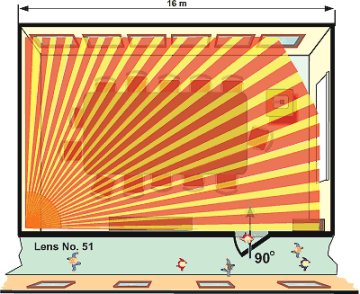13A. Presence-controlled air conditioning
Can be combined with presence-controlled lighting
| Premises
In many different types of premises it can be profitable to use presence detection to control air conditioning, since more energy is required to remove excess heat than to heat premises by the corresponding degree. This example shows a conference room, but presence detection can be used to control air conditioning in many different types of premises. Combining with lighting control Lighting can also be controlled by the same detector as part of the same system. This example shows a system where lighting is controlled using four levels or lighting groups together with presence-controlled air conditioning. Lighting can be switched on and off manually with pushbuttons, as normal, but if no one switches off the lighting it is switched off automatically when the premises are empty. (Lighting can also be set to switch on automatically, but this is not recommended.) The air conditioning is controlled automatically by presence detection. Light sources Light fittings can be fitted with conventional 50 Hz ballasts, non-dimmable or dimmable HF ballasts. In the latter case the lighting can be dimmed manually using a separate potentiometer that does not affect presence-controlled operation. Detector placement The placement of the detector is critical to operation! The diagram below shows where the detector should be positioned. In combination with a 51 lens, which permits installation higher up, this gives optimum detection on entry. It also means that the detector cannot see out through an open door, so the air conditioning is not switched on or left at the comfort setting when people pass in the corridor outside. |
Control system
The air conditioning is switched between two temperature settings: base cooling (when premises are empty) and comfort cooling. This is done by an additional thermostat (for base cooling), which, when presence is no longer detected, is coupled in by a relay output on the PD-2200 IR detector, which is connected in line with the built-in air conditioning thermostat. The method of connection must be tailored to the individual air conditioning system. Contact the supplier of the air conditioning system for advice. See the schematic diagram on the next page. Presence-controlled air conditioning and lighting The air conditioning is basically controlled in the same way as in the example above, but using two temperature sensors for base cooling (empty premises) and comfort cooling. The air conditioning unit is also switched off completely if the premises remain empty for an extended period 90 minutes in the example. This is done by using relay output 5 on EX-13 to switch off the power supply to the air conditioning unit via a contactor. The lighting is divided into three groups by EX-13 to permit presence control. The lighting can be switched on manually (recommended) or automatically. The three lighting groups could, for example, be blackboard lighting, ceiling light fittings and lighting for the speaker. When presence is no longer detected the lighting is switched off automatically after the set time (3 – 5 minutes). Hidden savings potential The EX-13 logic module makes it possible to exploit the hidden savings potential by not switching on the lighting automatically when people enter the premises. If the natural light is adequate the lighting is not switched on. The desired lighting groups can be switched on using pushbuttons if required.
|
||||||||||||||||||

See wiring below!
Schematic diagram of conference room with presence-controlled air conditioning |
|||||||||||||||||||
 |
Presence-controlled air conditioning offers major benefits
The air conditioning is switched between two temperature settings: base cooling (when premises are empty) and comfort cooling. This is done by an additional thermostat (for base cooling), which, when presence is no longer detected, is coupled in by a relay output on the PD-2200 IR detector, which is connected in line with the built-in air conditioning thermostat. The method of connection must be tailored to the individual air conditioning system. Contact the supplier of the air conditioning system for advice. Information for current budget
|
||||||||||||||||||
|
Schematic diagram of conference room with presence-controlled
Information for current budget
|
|||||||||||||||||||









